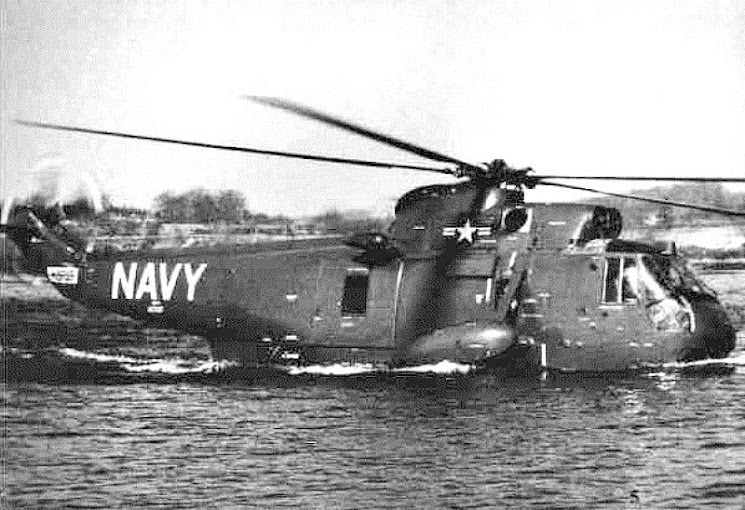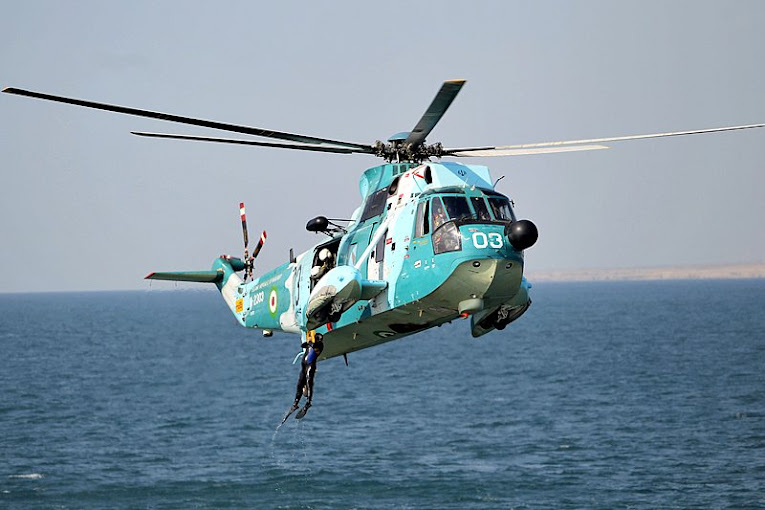Terminus Mos: It is, as Heli1 has said, due to the fact that SFO's routes criss-crossed the San Francisco bay area and, although their trips were typically only around 10mins in duration, most of that time would be spent over water.
Regarding the sponsons being a North Sea modification .. you may wish to consider the following:
As the Cold War between the US and the Soviet Union developed, the Soviet Navy had elected to construct a fleet of over 200 submarines, the US Navy chose to counter this threat by investing in newer and increasingly capable ASW technologies and platforms, in particular the Sikorsky Sea King. In 1957, Sikorsky was awarded a contract to develop an all-weather amphibious helicopter for the US Navy. The new helicopter would excel at anti-submarine warfare (ASW) and would combine the roles of hunter and killer (previously these had to be performed by two separate helicopters). The key features of the emerging ASW helicopter would include its amphibious hull for landing on the water, and its twin-turboshaft engines that enabled a larger, heavier and well-equipped aircraft than prior helicopters.
The first prototype took flight for the first time in March 1959. Carrier suitability trials were conducted on board the USS Lake Champlain; the trials were completed successfully in mid-1961. Production deliveries of the HSS-2 (later designated SH-3A) to the US Navy began in September 1961, these initial production aircraft were each powered by a pair of General Electric T58 turboshaft engines.
 The very first Sea King prototype XHSS-2 demonstrates its capability of landing on water in March 1959
The very first Sea King prototype XHSS-2 demonstrates its capability of landing on water in March 1959
 The amphibious design of the Sea King's lower fuselage, including sponsons, can be clearly seen in this Iranian Navy example
The amphibious design of the Sea King's lower fuselage, including sponsons, can be clearly seen in this Iranian Navy example
Sikorsky were quick to develop a commercial model of the Sea King resulting in the first flight of the S-61L on 2 November 1961. It was 4 ft 3 in (1.30 m) longer than the HSS-2 and could carry a greater payload. Initial production S-61Ls were powered by two 1350shp (1005 kW) GE CT58-140 turboshafts, the civil version of the T58. The S-61L featured a modified landing gear without the sponsons. Los Angeles Airways was the first civil operator of the S-61 introducing them on 11th March 1962. At that time a new S61 cost USD 650,000.
On 7th August 1962 the S-61N made its first flight. Otherwise identical to the S-61L, this version was optimised for overwater operations by retaining the SH-3's sponsons. Both the S-61L and S-61N were subsequently updated to Mk II standard with improvements including more powerful CT58-110 engines giving better hot and high performance, vibration damping and other refinements.
I had an interesting discussion, oh many years ago now, with a friend of mine from the Ukraine who (literally) swore that the Russian Mi-14 was the first truly amphibious helicopter and that Sikorsky had 'poached' the idea from the Mil factory. Aside from the fact that there are very few Western aircraft which have been inspired from Russian/Soviet designs this claim was simply factually inaccurate!
The Mi-14 (from every reliable source I know) is not credited with having been developed until about the mid-60's while (as you can see from above) the Sea King was quite literally 'in the water' in early 1959. I suspect my freind may have been leaning on the Mi-14's developmental airframe (which was an Mi-8) which, although designed a year before the Sea King flew, did not itself fly until 1961. (Even then .. this was not the amphibious version).
 The Mi-14 during waterborne trials in the mid-60's
The Mi-14 during waterborne trials in the mid-60's
 The Mi-14's amphibious hull in evidence in the Polish Air Force example
The Mi-14's amphibious hull in evidence in the Polish Air Force example
Another amphibious 'hulled' aircraft (in which Sikorsky were involved) was Sud Aviation's Super Frelon.
However, when you mention the 61, sponsons and the North Sea .. yes .. you are correct in that for an appreciable period of time the S61N was synonymous with North Sea operations .. with Bristows, British Airways and British Caledonian all using them .. and others too!
And just in case you think it was only test pilots and the military who engaged in water landings ..
 A KLM S61N PH-NZA during water landing and taxiing exercises
A KLM S61N PH-NZA during water landing and taxiing exercises
Several civilian operators (not just KLM) would regularly carry-out water landings for training purposes.